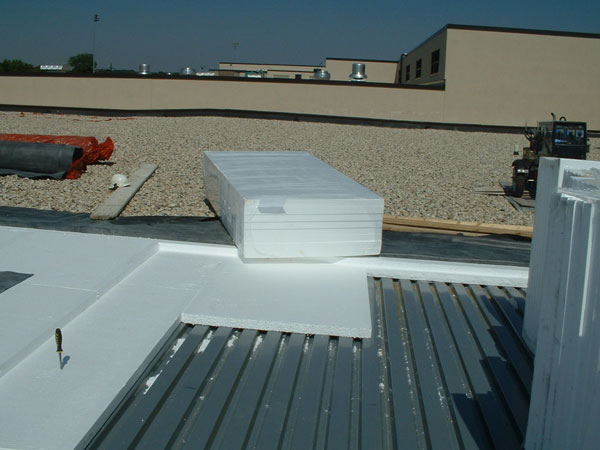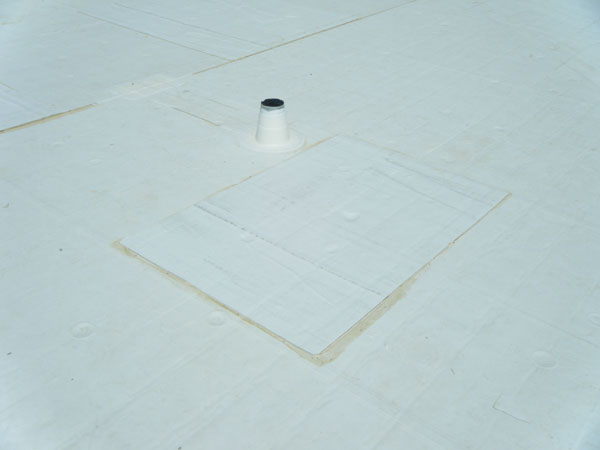by Gregory Havel
Until the 1970s, the “built-up roof” of layers of tarred felt mopped with asphalt, bitumen, or coal tar pitch was the standard membrane used for large-area flat roofs. Some of these roofs left the mopped asphalt surface exposed, while others covered it in pea-gravel to reflect sunlight and ultra-violet radiation and to reduce the amount of heat absorbed in hot weather. An advantage to these roofs was that after years of weathering they could be resurfaced by adding more layers of mopped asphalt and felt.
In the 1970s, several manufacturers began selling roof “membranes” made of rubber, synthetic rubber, and several types of plastic. These membranes were designed to be installed over insulation board of various types that was mechanically fastened to the roof deck with nails or screws or attached to the roof deck with adhesives. The roof membrane was designed to be attached to the insulation board with adhesives or to be mechanically fastened only at the edges or parapet walls and weighed down with large gravel ballast. In this latter case, the insulation board could be unattached to the roof deck.
Common thicknesses of synthetic rubber or plastic roof membranes are 45-60 mils, although some brands are available in 80-120 mils. (A mil is one thousandth of an inch (0.001 inch), or 0.0254 mm.) Thicker material gives more durability and means a longer life for the roof.
The most common types of flat roof membranes still used today are:
- Ethylene propylene diene monomer (EPDM), a synthetic rubber. It’s available in black or white and most commonly installed today as directly-adhered or ballasted.
- Chlorosulfonated polyethylene (CSPE), a synthetic rubber. Available in black or white; it’s most commonly installed today as direct-adhered or ballasted.
- Polyvinyl chloride (PVC), a plastic; available in black, white, gray, or other colors. Most commonly installed today as directly-adhered.
- Thermoplastic polyolefin (TPO), a plastic; usually available in white and directly adhered.
Other types of plastics and synthetic rubbers that were manufactured as roofing materials are no longer available, although there are still many buildings that have roofs of these materials.

Photo 1 shows a roof being installed on a school building. Over the steel roof deck (welded to the steel bar joists) are:
- Two layers of fire-retardant extruded polystyrene insulating board in 4×8 foot sheets each 4 inches thick, laid loose on the roof and on each other with the joints between sheets offset by 2 feet.
- A layer of EPDM roof membrane, laid loose on the insulating board and mechanically attached only at the edges of the roof. The seams between rolls of EPDM are overlapped with adhesive and the exposed edges are sealed.
- Two inches of large gravel ballast to hold the roof membrane and insulating board in place and to reflect sunlight and ultra-violet light.

Photo 2 shows a direct-adhered roofing system that is complete. This has a similar structure to the building in photo 1:
- A steel roof deck, welded to steel bar joists.
- Two layers of fire-retardant extruded polystyrene insulating board in 4×8 foot sheets each 4 inches thick, attached to the roof and to each other with adhesive with the joints between sheets offset by 2 feet.
- A layer of EPDM roof membrane, attached to the top layer of insulating board with adhesive. The seams between rolls of EPDM are overlapped with adhesive and the exposed edges sealed.
- The white surface of the EPDM reflects sunlight and ultraviolet light.
These membrane roofs today have thicker insulation than the built-up roofs of the past. As a result, a gasoline-powered circular saw may not have enough blade depth to cut through the roof membrane, insulation board, and steel deck in one pass. It may be necessary to cut a larger opening through the insulation board and a second smaller opening through the steel roof deck.
The rapidly-rotating saw blade will generate enough heat to soften or melt the plastic insulation and to generate toxic smoke—an excellent reason to use self-contained breathing apparatus while doing this type of work, besides the smoke that will rise from the fire below. Take care not to cut the top members of the bar joists with the saw, as this can result in the failure of that part of the roof.
See the July 2010 “Construction Concerns” article titled “Combustible Metal Deck Roofs” for a discussion of the influence of a fire below on combustible roofing materials.
Since roofs today are built to carry their own weight plus that of an amount of accumulated rain or snow derived from the building code tables without enough safety factor to hold several firefighters ventilating with fire below, we should look for other means and methods of ventilation before we stand upon the roof we plan to cut.
Download this article as a PDF HERE.
 Gregory Havel is a member of the Town of Burlington (WI) Fire Department; retired deputy chief and training officer; and a 30-year veteran of the fire service. He is a Wisconsin-certified fire instructor II, fire officer II, and fire inspector; an adjunct instructor in fire service programs at Gateway Technical College; and safety director for Scherrer Construction Co., Inc. Havel has a bachelor’s degree from St. Norbert College; has more than 30 years of experience in facilities management and building construction; and has presented classes at FDIC.
Gregory Havel is a member of the Town of Burlington (WI) Fire Department; retired deputy chief and training officer; and a 30-year veteran of the fire service. He is a Wisconsin-certified fire instructor II, fire officer II, and fire inspector; an adjunct instructor in fire service programs at Gateway Technical College; and safety director for Scherrer Construction Co., Inc. Havel has a bachelor’s degree from St. Norbert College; has more than 30 years of experience in facilities management and building construction; and has presented classes at FDIC.
MORE CONSTRUCTION CONCERNS

